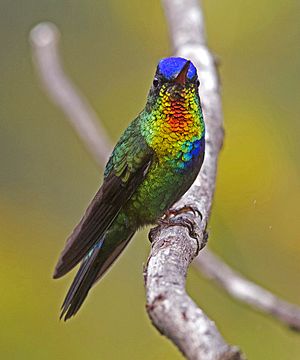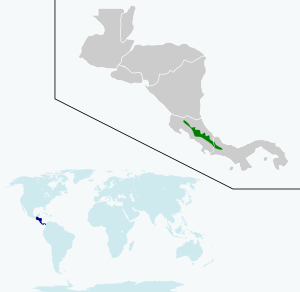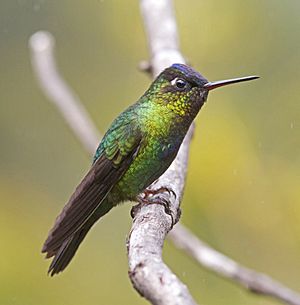Fiery-throated hummingbird facts for kids
Quick facts for kids Fiery-throated hummingbird |
|
|---|---|
 |
|
| Paraiso del Quetzal, Costa Rica | |
| Conservation status | |
| Scientific classification | |
| Genus: |
Panterpe
|
| Species: |
insignis
|
 |
|
The fiery-throated hummingbird (Panterpe insignis) is a beautiful bird. It is a type of hummingbird that lives in the mountains. You can find this special bird in Costa Rica and Panama. It belongs to a group of hummingbirds called "mountain gems."
Contents
About the Fiery-Throated Hummingbird
The fiery-throated hummingbird is the only bird in its group, called Panterpe. Think of it like a unique family with only one member! There are two slightly different kinds of this hummingbird. Scientists call these "subspecies." They are named P. i. insignis and P. i. eisenmanni.
What Does It Look Like?
This hummingbird is quite small, about 10.5 to 11 centimeters (4 to 4.3 inches) long. Males are a bit heavier than females. Both male and female birds look very similar. They have a mostly black beak with a pink bottom part. You can also spot a tiny white dot behind their eyes.
The main type, P. i. insignis, has a shiny royal blue crown on its head. The rest of its face and neck are black. Its back is a bright metallic green. This color changes to bluish-green near its tail. The tail itself is a dark blue-black.
The most amazing part is its throat! It glows with a brilliant rosy coppery orange color. The sides of its throat are golden green. It also has a patch of violet-blue on its chest. The rest of its belly is bright green or blue-green.
The other type, P. i. eisenmanni, is a little smaller. Its beak is also shorter. The black color from its neck goes further down its back. The blue-violet on its chest spreads more onto its belly. Its tail feathers are mostly blue.
Where Does It Live?
The main type of fiery-throated hummingbird lives in Costa Rica and western Panama. The other type, P. i. eisenmanni, only lives in a specific mountain range in northwestern Costa Rica.
These birds like to live in different kinds of forests. This includes mountain forests, misty cloudforests, and even "elfin forests." Elfin forests are special forests with small, twisted trees. They also live in more open areas. You might see them in places where forests are growing back or in pastures with many trees.
They usually stay high up in the trees. But sometimes, you can spot them in shrubs at the edge of the forest or in open spaces. In northern Costa Rica, they live at high elevations, from about 1,600 meters (5,250 feet) up to 2,000 meters (6,560 feet). In higher mountains further south, they live even higher, between 2,200 and 3,200 meters (7,200 and 10,500 feet).
How It Behaves
Seasonal Movements
After they have their babies, some fiery-throated hummingbirds move to lower places. They usually don't go below 1,400 meters (4,600 feet). This might be to find more food or better weather.
What It Eats
The fiery-throated hummingbird loves to drink nectar from small flowers. They get nectar from flowers found on trees, shrubs, and plants that grow on other plants (called epiphytes). If a flower is too deep for its beak, this clever bird will sometimes make a hole to get the nectar. Bumblebees and other birds called flowerpiercers also make these holes.
These hummingbirds can be quite bossy! They are often stronger than most other hummingbirds. During the time they are having babies, male hummingbirds will protect their feeding spots. They let females eat there, but they chase away other males. After the breeding season, both male and female birds protect their own feeding areas. Besides nectar, they also catch small bugs while flying. Sometimes, they pick bugs off leaves too.
Reproduction and Life Cycle
In Costa Rica, fiery-throated hummingbirds have their breeding season from August to January. The female hummingbird does all the work of building the nest and sitting on the eggs. She lays two white eggs in a strong, cup-shaped nest. This nest is made of plant fibers. The outside is covered with moss and lichen, which helps to hide it.
The nest is usually placed about 2 to 4 meters (6.5 to 13 feet) high. It might be at the end of a hanging bamboo stem or under a bank on a root. We don't know exactly how long the eggs take to hatch or how long the babies stay in the nest before they can fly.
Bird Calls
The fiery-throated hummingbird doesn't seem to have a long, complicated song. Instead, it makes different calls. One call sounds like a repeated, squeaky "kek...kek..." that it says very fast. Another call is a quick, gurgling sound that suddenly gets higher in pitch.
Is It in Danger?
The IUCN (International Union for Conservation of Nature) says that the fiery-throated hummingbird is a "Least Concern" species. This means it is not currently in danger of disappearing. Even though it lives in a small area, there are many of these birds. Scientists believe there are between 50,000 and 500,000 adult birds. Their numbers seem to be staying steady. A lot of the places where they live are protected in parks and nature preserves. So, you can find them quite often in their habitat.
See also
 In Spanish: Colibrí insigne para niños
In Spanish: Colibrí insigne para niños



